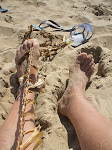A descendant moon in the dormant season signifies that it is the moment to harvest the willows, so that has been the task of the week. Coincidentally it has also been a week of discussion about the British Governments desire to sell off the remaining publicly owned woodlands of England to pay off some of the national debt, and in a strange way the two have become connected.
The land the willows grow on belongs to my neighbour. Having cut down some large poplars that were being cultivated there for timber, he had no further plans for the land and offered it to us for planting willow and we gratefully accepted. That was nearly 20 years ago and only a quarter of the available space was planted at that time, but it has been added to every year since. It now measures about 12 metres by 6 and has several varieties that have survived out of the 50 plus that have been tried there.
 |
| Willow bed January 2011 looking East |

It used to be a real pleasure to go down to the willows on a sunny winters day. A stand of scrubby trees on the north side of the plot gave protection from cold winds which, together with a mini wood of ash trees choked with wild clematis on the eastern side, created a warm micro-climate where you could work unfettered by layers of thick clothing or gloves.
 |
| Stream January 2011 |
Running along side the willow bed was a stream that originated from a small bubbling source and because the water was always there I pitted the willows for peeling in it. It was an oasis set amongst the mixed landscape of fields and the little strips of potager.
 |
| Willows pitted in stream January 2000 |
Things began to change several years ago. As the older villagers died so their potagers were ploughed into the fields, their children choosing to buy their vegetables rather than grow them. Then the trees on the north side that provided our micro climate were chopped, and the searing north winds that often blow on sunny winter days now makes working there unpleasant. Last winter it seemed that every time we went to the plot a tractor would appear grinding noisily up and down the field spraying some noxious powder over the land and, with the aid of the north wind, us and our organically grown willows too. (This article confirms my fears.) .
http://www.telegraph.co.uk/foodanddrink/wine/8274192/French-winegrowers-warned-over-pesticide-use.html

By August the track to the willows had become a canyon in between the giant brutish maize plants that bear no relation to their delicate South American ancestors and which are apparently always thirsty. The indigenous agri-business method for quenching this thirst appears to be astonishingly stupid. The water is pumped up from the water table and then often on a really hot day sprayed high into the air over the maize from a giant sprinkler in the hope that some of it reaches the ground. According to R.D.P.E statistics
http://www.eau-poitou-charentes.org/usages/Usage-et-consequences,24.html it takes 500-1,000 litres of irrigated water to make 1kg of maize. This maize, which is unfit for human consumption, is fed to the pigs that live in sheds, never seeing the light of day or feeling sun on their skin, and which end up in pieces in the supermarkets "foires des porcs" of January at about 2€ a kilo. How do the sums add up, pork that is cheaper per kilo than cabbages?
 |
| Dry stream September 2010 |
It is hardly surprising then that last year for the first time we saw a gaping hole in the dry stream bed where the spring should have been, and it wasn't until November that water started to bubble up again.
Needless to say it wasn't a good willow harvest.
Reflecting on all this in the biting wind with freezing fingers trying to grasp the secateurs, I began to tell myself that we should stop doing this work. It is not much fun and I don't really need the willows, there are plenty of other available materials that I can use to make baskets with, but if we stop cultivating this little plot the trees surrounding it will be cut and the maize will be moved in. It struck me then that the only difference between Brazilian deforestation and the European version is that we have already done it.
Here is a link to a petition to halt the sell off of Englands publicly owned woodlands
http://www.38degrees.org.uk/page/s/save-our-forests#petition Thank you Barbara.
























